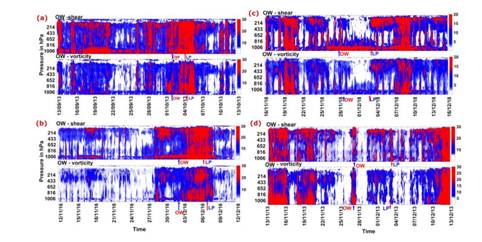The novel technique could help detect tropical cyclones for the Bay of Bengal Basin earlier than satellites
By PIB Delhi
Indian Scientists have found a promising technique for early detection of development or strengthening of tropical cyclones in the atmospheric column prior to satellite detection over ocean surface in North Indian Ocean region.
Early detection of Tropical cyclones has wide socio-economic implications. So far, remote sensing techniques have detected them the earliest. However, this detection was possible only after system developed as a well-marked low-pressure system over the warm ocean surface. A larger time gap between the detection and the impact of the cyclone could help preparation activities.
Prior to the formation of cyclonic system over the warm oceanic environment, the initial atmospheric instability mechanism, as well as the vortex development, is triggered at higher atmospheric levels. These cyclonic eddies are prominent features in the vertical atmospheric column encompassing the disturbance environment with a potential to induce and develop into a well-marked cyclonic depression over the warm ocean surface. They could be used for detection of prediction of cyclones
A team of Scientists including Jiya Albert, Bishnupriya Sahoo, and Prasad K. Bhaskaran from IIT Kharagpur, with support from the Department of Science & Technology, Government of India under the Climate Change Programme (CCP), devised a novel method using Eddy detection technique to investigate the formative stages and advance detection time of tropical cyclogenesis in the North Indian Ocean region. The research was published in the journal ‘Atmospheric Research’ recently.
The method developed by the scientists’ aims to identify initial traces of pre-cyclonic eddy vortices in the atmospheric column and track its Spatio-temporal evolution. They used coarser grid resolution of 27 km for identification and finer resolution of 9 km to evaluate the characteristics of eddy vortices. The study was conducted with cases of four post-monsoon severe cyclones –Phailin (2013), Vardah (2013), Gaja (2018), Madi (2013), and two pre-monsoon cyclones Mora (2017) and Aila (2009) that developed over North Indian Ocean.
The team observed that the method could bring about genesis of prediction with a minimum of four days (~ 90 h) lead time for cyclones developed during the pre-and post-monsoon seasons. Initiation mechanisms of genesis of tropical cyclones occurs at upper atmospheric levels and are also detected at higher lead time for pre-monsoon cases, unlike the post-monsoon cases. The study made a comprehensive investigation on the behavior of eddies in an atmospheric column for non-developing cases and compared these findings with developing cases.
The technique was found to have potential for early detection of tropical cyclogenesis in the atmospheric column prior to satellite detection over ocean surface.

Figure: Hovmöller diagram representing the shear and vorticity components of Okubo-Weiss Zeta Parameter (OWZP) for cyclones (a) Phailin, (b) Vardah, (c) Gaja, and (d) Madi corresponding to inner domain (9 km resolution). Blue marker represents atmospheric pre-cyclonic eddies detection using OWZP technique, and the red marker represents satellite detection of low-pressure over warm ocean surface.





















